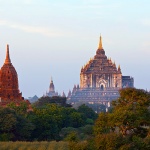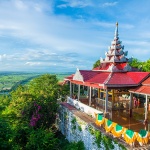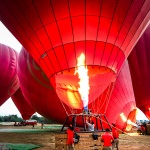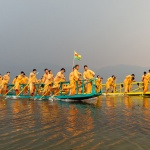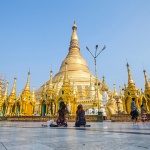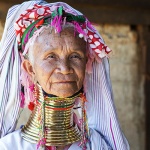DAY 1: An Intriguing Adventure – Answering Bagan’s Call
by Uma Mageshwary Gunasakaran
Though now listed on UNESCO’s World Heritage Site list, Bagan has been no stranger to history and culture enthusiasts for decades. Word of its countless ancient monuments and pagoda-rich plains have travelled far and wide, beckoning travellers from all over the world to marvel at its archaeological wonder. Bagan also signifies the achievement of Theravada Buddhism embedment in Myanmar preceding its transformation into a renowned religious centre. As a result, it has become a prominent pilgrimage site. Tens of thousands of thrill-seekers and avid photographers also flock to Bagan during its ballooning season from October to April each year. The balloon rides offer a birds-eye view of all the temples, stupas, and golden spires in the glimmering rays of dawn, and it is undeniably glorious. Therefore, hardly any traveller to Myanmar would miss out on the chance to visit this breath-taking city, and they all leave with a sense of amazement. Having learnt this much about Bagan, we simply could not hold ourselves back any longer from experiencing it first-hand. We travelled to Myanmar during the monsoon season and honestly, it can be a tad challenging. The month of July promises heavy downpours, however there were days we were fortunate to enjoy a couple of dry hours to explore Bagan.
Getting into Bagan from Yangon is quite effortless with Myanmar’s extensive bus, train, and flight networks, and also the luxury of private car transfers. There is a selection of convenient and user-friendly platforms for booking bus trips around Myanmar, such as Myanmar Bus Ticket, BNF Express, MM-Bus Ticket, etc.
We first booked our bus trip via Star Ticket where a one-way trip was only 18500 Kyat (approx. USD12) on a 30-seater VIP bus. Star Ticket displays all available options of different classes of buses, including clear timings, duration of travel, and also a seat map for each bus to choose your specific seat. Its customer service is also very responsive and helpful. As the bus trip from Yangon to Bagan was 9 hours and we were pressed for time, we decided to fly to Bagan.
For adventurous souls who would like to experience a slower-paced commute to Bagan from Yangon, rubbing shoulders with kindred spirits and locals, boarding a 17.5-hour train is another option. However, advance booking is highly recommended to ensure a relatively comfortable journey in a 4-person sleeper berth. Tickets can be purchased at the Yangon Central Railway station up until the day of travel or on Myanmar Train Ticket website at least 7 days ahead of intended travel date.
A pleasant 80-minute flight on an ATR72 with Myanmar National Airlines transported us out of the bustling city of Yangon to greener pastures. Bagan, formerly known as Pagan, was founded around the second century AD, which later became the centre of amalgamation of the Irrawaddy Valley and its surrounding areas by the Pagan empire in the 9th century.
This unified area is modern-day Myanmar. Upon arriving at the Nyaung-U airport and paying a fee of 25000 Kyat (approx. USD17) to enter this magnificent city, friendly faces and a line of taxis greeted us offering a comfortable ride to our resort. They can also be engaged for tours around the city. A 10,000 Kyat and 20-minute taxi ride later, we arrived at beautiful resort by the bank of the Irrawaddy river in Old Bagan, the Bagan Thiripyitsaya Sanctuary Resort.
The name says it all as it’s a perfect establishment to seek refuge from the hustle and bustle of the city. The resort sprawls over a vast compound of well-manicured gardens. We exchanged smiles and greetings with staff tending to the flowering shrubs as we walked to our room which was 1 of 4 rooms joined as a cottage. There is a small monastery complex occupying a small space just 50 metres away from the reception. It’s called the Kaladha Koun, a simple shrine, yet exudes an aura of tranquility.
You can hire an electric bike directly from this resort to explore the 100km2 archaeological zone without busting your budget, about 5000 kyat for 4 hours or 10,000 kyat per day. They were in excellent condition, which was the most important aspect for us. We also realised that we do not need a motorcycle license to ride e-bikes. And the great thing about the e-bikes is that they can be parked closer to the temples compared to cars, and not to mention, it significantly reduces your carbon footprint, so it’s a great win-win.
We decided to hire the e-bikes only the next day as we can make full use of them then. After a relaxing stroll around our resort grounds, our tummies started to rumble. As we are big supporters of training restaurants, we found Sanon and took a 15-minute taxi ride there. We liked the menu as the dishes were mostly modernised Burmese cuisine or a fusion of Western favourites with Burmese flavours. The service was excellent and the food was sublime. We enjoyed the Giant Irrawaddy Prawn & Catfish curry. The prawn was indeed huge and juicy. We also ordered Grilled Tilapia, the flavours were a good balance of tangy and spicy. With that satisfying meal and the anticipation of next day’s adventure, we called it an early night.
DAY 2: The Ancient City Of Bagan – Traveller Marvels At Myanmar’s First Kingdom
We rose early with excitement. After a balanced breakfast and a quick briefing by the Thiripyitsaya e-bike service, there was nothing left to do but traverse the plethora of majestic temples and be awed. From our resort, we zoomed away on our e-bikes to the Bagan Archaeological Museum in less than 5 minutes. This is a great place to start as it furnished us with the background of Bagan and the details of its iconic edifices. Those who yearn to learn more can hire a guide to grasp a better understanding of the history and culture of Myanmar’s first kingdom for a fee of 10000 Kyat.
Here we learned that between the 10th to 13th centuries, Bagan flourished as the economic and cultural capital of the Pagan kingdom, and more than 10,000 Buddhist temples, monasteries, and stupas were erected over the course 250 years of the kingdom’s rule. Today, about 2200 of those incredible monuments still remain, surviving years of earthquake trauma. Next stop, the highest awe-inspiring structures of Bagan, the Thatbyinnyu Phaya. At a height of 60 meters, this stunning structure was built to symbolise the omniscience of Lord Buddha. It should be noted that modest attire is required to enter the temples. However, fret not if you are in your summer shorts as longyis and shawls can be purchased outside the more popular temples.
Just a stone’s throw away from Thatbyinnyu, is an elevated platform bearing a beautiful temple frequented by sunrise and sunset-hunters. The Shwe-Gu-Gyi Phaya’s narrow stairways to a higher platform provides an amazing view of the plain dotted with numerous temples and its golden spires, and stupas. The unique temple of Dhamman-Gyi, which we managed to visit last, is located 3 kilometres south east of Shwe-Gu-Gyi. If time is of essence or the weather does not permit your visit to Dhamman-Gyi, the consolation is a good view of it from the higher level of Shwe-Gu-Gyi. As this is one of the most popular temples in Bagan, there were many vendors selling a variety of fabric, trinkets, and artwork here. We also saw local children playing with toys which brought back nostalgia of our childhood. Another 5-minute ride to the east is a must-see 12th century temple, the Ananda, which has been splendidly restored succeeding the earthquake impact. The interior of this temple houses numerous wall niches, occupied by small Buddha statues, surrounding the four colossal Buddha statues facing each cardinal direction. We entered via the north entrance, past the bustling street market. Once we stepped past the massive arched gateway, the atmosphere turned serene and divine. It’s worth spending more time here walking through the courtyard, admiring the impressive architecture, gilded shikhara and capture a panoramic shot of this beauty – definitely Insta-worthy.
Local child playing outside the Shew-gu-gyi temple.
Our morning exploration made us crave nourishment in the form of hearty Burmese cuisine by noon. A short ride north of the Ananda temple brought us to a cluster of restaurants where we let the crowd influence our decision to dine at the Golden Myanmar 2 restaurant. We knew it was wise choice 2 minutes after placing our orders, when a wide variety of vegetable accompaniments came to our table. Little did we know that it was a buffet-style eatery, the dishes are replenishable but the first round alone was overly satiating. Then, our meat dishes were served. All for 5000 kyat per person. Fully recharged, we reembarked on our mini adventure and visited a few more temples and stupas before succumbing to the afternoon heat and calling it a day.
The trip to the Sulamani temple is a relatively longer commute, 10 minutes ride along a dusty road. The white prints on my longyi had turned reddish brown by the time I reached the temple. Sulamani stands out for its vaulted corridors are illuminated by the sunlight reflecting off the gold-leafed Buddha statues at different angles throughout the day, providing striking natural lighting along the walkway. Another breath-taking feature is the intricate ceiling murals and wall paintings that have survived centuries of weather abrasion.
Next door to Sulamani is the Dhammayan-Gyi temple. Unlike the other notable temples, its interior is bricked up which can be related to its unpleasant history circling King Narathu. Legend has it that Narathu ascended the throne by smothering his bed-ridden father, King Alaungsithu who led the kingdom to its prosperity in the 10th century and motivated the erection of numerous temples. When Narathu’s elder brother, Min Shin Saw led his army to claim his right to the throne, Narathu deceitfully surrendered but later murdered Min Shin Shaw during his coronation by poisoning his first meal as the king.
During his reign, King Narathu sacrificed one of his wives in a ritual. She was an Indian princess and her grief-stricken father prompted the assassination of King Narathu in 1171. Dhammayan-Gyi was built by King Narathu in attempt to atone for his sins and neutralise his bad karma, and also in the name of his maternal grandfather, Dhamma Kyin. It was not completed by the time of his demise, so the workers filled the inner ambulatories with rubble out of spite. Today, Dhammangyi-Gyi stands out as the largest and widest of all the temples within the Bagan Archaeological Zone. Its outstanding brickwork is worth the wander.
All the monuments visited in just 4 hours can leave one temple-d out for the day. The first drop of rain was our cue to retire for the day and submit to a relaxing herbal-oil massage back at the resort. We only managed to fit in 5 of the note-worthy temples and a few minor ones along the way in one day. Hence, 3 days in Bagan is recommended to visit the other must-see monuments such as the Shwesandaw pagoda known for its picturesque sunset spot, the Shwezigen temple which is similar to the Shwedagon in Yangon minus the enormous golden spire, the Maha Bodhi Phaya which style is influenced by the famous Bodh Gaya temple in India, and the Golden Palace which is a recreation of the original ancient palace which is being presently excavated. Apart from the Archaeological zone, the Mani-Sithu market and lacquerware workshop is also popular amongst tourists. We left Bagan with a heavy heart the next morning, but Mandalay beckons, and off we were on another adventure.

